- May 15
- Drug Addiction Treatment
Although addiction is a complex condition that affects each individual differently, some populations face a set of unique challenges when it comes to substance misuse and getting treatment. The LGBTQ community faces various risk factors for addiction and barriers to treatment that other groups simply do not, making them exceptionally vulnerable to substance misuse. Whether you are LGBTQ yourself or know someone who is, understanding more about LGBTQ addiction recovery can save a life.
- Substance Misuse and Addiction Among Individuals in the LGBTQ Community
- Why Is the LGBTQ Community at Higher Risk for Addiction?
- Factors Influencing Addiction in the LGBTQ Community
- Trauma Among LGBTQ Populations
- What Is an LGBTQ Rehab Center?
- What to Look for in an LGBTQ Treatment Center
- LGBTQ-Inclusive vs. Affirmative Treatment
- At Gateway Foundation, We Are With You for Life
Substance Misuse and Addiction Among Individuals in the LGBTQ Community
Addiction occurs at much higher rates among the LGBTQ community compared to the general population. Although research about specific gender and sexual identities in the context of substance misuse is still somewhat lacking, we have two powerful data sets that give an idea of the issue’s scope.
The National Survey on Drug Use and Health (NSDUH) is a survey conducted annually by the Substance Abuse and Mental Health Services Administration. It gathers information from people aged 12 and over. The last time the NSDUH included information on sexual identity was in 2015, when it asked people to self-identify if they were gay, lesbian, or bisexual. This survey did not consider transgender or questioning identities but provides a good starting point for examining LGBTQ substance misuse.
Key findings of the 2015 NSDUH include:
- About 39% of surveyed adults used illicit drugs in the past year compared to 17% of heterosexual adults.
- Approximately 63% of surveyed adults drank in the past month, compared to 56% of heterosexual adults.
- Just over 15% of lesbian or bisexual women were more likely than heterosexual women to be current drinkers.
Another study from the University of Michigan involved reviewing data from the 2012 to 2013 National Epidemiological Survey on Alcohol and Related Conditions-III. This data came from more than 36,300 adults, of which around 6% identified as sexual minorities.
Researchers determined that those who self-identified as gay or lesbian were more than two times as likely as heterosexuals to have an alcohol or tobacco use disorder categorized as “severe.” Meanwhile, bisexual respondents were three times likelier to have a severe substance use disorder, putting this group at even greater risk.
Being unsure of one’s sexual identity is even more closely associated with addiction. This group is five times more likely to have a substance use disorder than straight people.
While it has long been known that LGBTQ substance misuse is more prevalent than substance misuse by heterosexuals, this particular study was the first and largest to use a sample size big enough to represent the U.S. population. Past studies have been much less comprehensive and had serious issues with sample sizes and recruitment of subjects.
Carol Boyd, Ph.D., RN, and professor at the University of Michigan School of Nursing, points out that some researchers would go out to bars to find gay men and ask them about their drug and alcohol use. This type of approach skewed results toward even greater rates of substance misuse in the community. Other studies focused solely on alcohol while ignoring other substances, leading to an incomplete picture of widespread misuse and addiction. The University of Michigan study closes many of these gaps with its huge sample size and attention to tobacco, alcohol, and other misuse substances.
Transgender Substance Misuse Rates
While the NSDUH survey represents a significant leap forward in research on substance abuse in the LGBTQ community, there’s one notable omission: The “T.” There is a glaring gap in the literature regarding addiction and transgender people. The majority of studies covering LGBTQ substance abuse don’t ask people about the gender they were assigned at birth compared to the gender they identify as in the present. However, one study from California proves that being transgender comes with an elevated risk of addiction to dangerous substances.
The 2013-2015 California Health Kids Survey (CHKS) showed that students who were transgender were around 2.5 times more likely to use cocaine and methamphetamine than their classmates.
The National LGBT Health Education Center reveals that transgender women and trans-feminine youth are at particular risk. Transgender women who experience psychological abuse due to their non-conforming gender identity have:
- Three to four times higher odds of using marijuana, cocaine, or alcohol.
- Eight times higher odds of using any substance.
Why Is the LGBTQ Community at Higher Risk for Addiction?
The elevated risk of LGBTQ substance misuse stems from three main factors:
- Stress: Many LGBTQ people live in a state of nearly constant stress. It comes from widespread stigma and prejudice that permeates everyday life and can cause people to seek out substances to relieve stress.
- Discrimination: Discrimination is something LGBTQ people must deal with as they move through life. Discrimination is built into so many of our systems, from housing to healthcare, that most heterosexual people don’t realize the multitude of difficulties LGBTQ people have to overcome to live a normal life.
- Targeted marketing: Legal substances, like alcohol and tobacco, are purposely marketed to gay and transgender people due to the connection between the community and bars.
Factors Influencing Addiction in the LGBTQ Community
The factors that influence LGBTQ substance misuse are many, and they can be overwhelming for those who experience them. Some of the factors that drive LGBTQ people toward addiction are:
1. Minority Stigma
Although progress has been made politically and socially to promote acceptance of the LGBTQ community, progress has been slow to arrive. It has not permeated the culture thoroughly by any means. Anti-gay and anti-transgender prejudice can be seen in all corners of the nation. Every person in the community has likely experienced at least one incidence of discrimination in their lives — and this prejudice doesn’t have to be overt, although it often is.
LGBTQ people are forced to live their lives with one eye on the people around them to avoid areas or settings where they are likely to experience verbal, emotional, or physical harm. The issue is even worse when prejudice is found in places that can’t be avoided, such as school or work. This creates a constant atmosphere of stress and anxiety, so many try to self-medicate with drugs or alcohol.
2. Employment and Housing Discrimination
Lack of security in employment is a significant stressor for anyone. Still, LGBTQ people must cope with a base level of discrimination that most people don’t have to worry about. In 29 states, it is legal for an employer to deny employment, fire, or discriminate against people due to their sexuality or gender identity. The Center for American Progress reports that 43% of gay people and 90% of transgender people have experienced discrimination and harassment in their workplace.
Discrimination at work is a constant threat to the livelihood of LGBTQ individuals. Job insecurity results in many community members being unable to receive a reliable income and also reduces the likelihood of having health insurance provided by an employer. This issue also affects partners, spouses, and children who are financially dependent on LGBTQ people, creating a ripple effect on their well-being.
Along with employment discrimination, LGBTQ individuals often face difficulty getting safe, stable housing for themselves and any dependents they may have. As housing is a critical element of maintaining employment, discrimination in this realm significantly affects well-being that may drive a person to cope with substance misuse.
3. Relationship Recognition Discrimination
For the past 20 years or so, the question of same-sex marriage has loomed over the LGBTQ community as their relationships are politicized and, in most cases, ignored.
Even though same-sex marriage was legalized in all 50 states in 2015, there is still an immense array of important public programs and policies out of reach for LGBTQ couples. For example, gay and lesbian couples — as well as couples where one or both individuals are transgender — frequently can’t access:
- Childcare tax credits
- Social Security survivor benefits
- Employer-sponsored health insurance
- Sponsorships for a partner’s citizenship
The lack of access to these crucial pieces of social infrastructure results in economic instability and the fear that comes with it.
4. Healthcare Discrimination
The U.S. doesn’t have public health insurance, and paying for individual coverage is often far too expensive to be a viable option. In combination with workplace discrimination, it is challenging for LGBTQ people to get consistent health coverage. For those who would typically get health insurance through their partner’s employer, being LGBTQ is a significant barrier. Many employers don’t provide insurance to same-sex domestic partners, and when they do, the couple has to pay tax on the insurance where heterosexual couples do not.
For transgender people who do manage to get healthcare, there’s more to worry about. Many private and public health plans make transgender people the target of specific exclusions, barring them from receiving any care related to their transition. This results in transgender individuals experiencing significant stress and anxiety around their health and transition.
Even when a transgender person does get a health plan that covers transitioning, there is the matter of finding an accepting and competent provider. Fear of judgment or even overt cruelty prevents many transgender people from going to the doctor, which worsens their overall health and reduces the number of potential intervention points for any substance misuse that may be occurring.
5. Targeted Marking
The LGBTQ community frequently misuses alcohol and tobacco. Clubs and bars have long been some of the safer places for gay and transgender people to gather and socialize, and marketers know this. Multiple alcohol brands target Pride annually, offering donations and colorful rainbow-themed alcoholic products to ingratiate themselves with the community. This highly effective marketing scheme explicitly aimed at LGBTQ people helps paint alcohol as innocuous rather than as a dangerous substance.
Trauma Among LGBTQ Populations
There is a strong and well-documented link between experiencing trauma and developing addiction. A traumatic event is any situation in which a person:
- Fears for their safety.
- Experiences intense pain.
- Experiences a tragic or violent event.
- Witnesses another person experiencing a violent event.
In many cases, trauma results from repeated or ongoing circumstances, like child abuse or domestic violence. No matter the source, trauma has a profound mental and emotional impact that often drives sufferers to self-medicate with drugs or alcohol. Rates of trauma are higher among LGBTQ people than in the general population, with LGBTQ individuals having a 1.6 to 3.9 times greater risk of post-traumatic stress disorder (PTSD). Estimates vary, but around half of the people seeking addiction treatment also have PTSD.
The following are some of the most common traumatic experiences LGBTQ individuals have in their lifetime.
Bullying and Harassment
or many LGBTQ people, trauma starts in school. GLSEN regularly conducts the National School Climate Survey to document the challenges LGBTQ students face at school. The most recent survey in 2017 asked more than 23,000 LGBTQ students ages 13 to 21 about their experiences. Its findings reveal the scope of traumatic events these students experience daily:
- 59.5% surveyed felt unsafe at school due to their sexual orientation, and 44.6% felt unsafe due to their gender expression.
- 70.1% surveyed experienced verbal harassment based on their sexual orientation, and 59.1% were verbally harassed based on gender expression.
- 95.3% surveyed heard homophobic comments, while a further 60.3% heard this language frequently.
- 56.6% surveyed reported hearing homophobic comments from teachers and other school staff, while 71% reported hearing teachers or staff making negative comments about gender expression.
- 28.9% surveyed experienced physical harassment, like being pushed or shoved, based on their sexual orientation, and 24.4% experienced physical harassment based on gender expression.
- 12.4% surveyed were physically assaulted based on sexual orientation, while 11.2% were physically assaulted based on gender expression.
- 48.7% surveyed experienced cyberbullying within the past year.
- 57.3% surveyed were sexually harassed in the past year at school.
To make matters worse, 55.3% of the victimized students chose not to report the issues to school staff due to fear of retaliation or doubt the school would respond. These fears are well-founded, as 60.4% of students who did make a report indicated that staff took no action or told the student to ignore the problem.
While any of these occurrences is enough to constitute a traumatic event when experienced once or twice, many LGBTQ youth are subjected to them constantly. Repeated or prolonged trauma can lead to complex PTSD, a condition with similar — but sometimes extreme or persistent — symptoms compared to traditional PTSD. What’s more, the prevalence of bullying and harassment often persists well into adulthood in the workplace.
Sexual Abuse
Sexual assault and abuse are significant sources of trauma, and the LGBTQ community experiences these events at disturbingly high rates:
- 47% of bisexual men and 40% of gay men have experienced sexual violence, in comparison to just 21% of straight men.
- 46% of bisexual women have experienced rape, in comparison to 17% of straight women.
- 47% of transgender people experience sexual assault at least once in their lives.
Any addiction program that uses trauma-informed therapy must address the acute and lasting distress sexual abuse causes.
Domestic Violence
LGBTQ people are more frequently subjected to domestic abuse and intimate partner violence. This is often due to people entering unhealthy relationships because of financial issues or self-esteem issues that lead to choosing unsafe partners. A 2015 report from the National Coalition of Anti-Violence Programs reveals these domestic abuse statistics among LGBTQ individuals:
- 20% have experienced physical violence at the hands of an intimate partner.
- 18% have been verbally abused.
- 13% have been threatened or intimidated.
LGBTQ people in unsafe relationships are often unlikely to seek treatment for fear of their partner’s retaliation.
Violence
Despite the social progress the LGBTQ community has made in recent decades, they still face wildly disproportionate levels of violence. According to the most recent FBI data, hate crimes against LGBTQ people accounted for 19% of all hate crimes in 2018.
LGBTQ individuals face a near-constant burden of stress living knowing that they are statistically more likely to face targeted violence from prejudiced strangers. That fear can contribute to complex PTSD and cause people to numb the fear through drugs or alcohol.
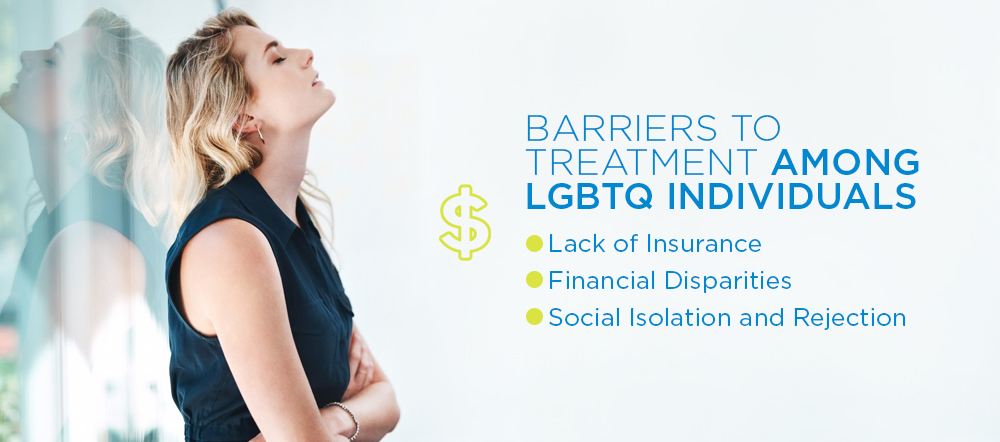
With the connection between LGBTQ and addiction clarified, it’s essential to look at what stops people within the community from seeking addiction treatment when they need it. There are three main barriers that LGBTQ people face:
1. Lack of Insurance
A fairly recent Gallup Poll shows that those in the LGBTQ community are much less likely to have health insurance than the general population. In many cases, this makes it completely impossible to access routine medical care, let alone a specialized LGBTQ addiction recovery program.
2. Financial Disparities
Even with insurance, LGBTQ people may not be able to afford treatment. Reports on the LGBTQ pay gap are few and far between, but many indicate that being gay, bisexual, or transgender results in less money. For example, a San Francisco tech industry study indicated that gay, bisexual, or transgender men were offered $3,000 less in salary than their straight counterparts. Making less money makes it much harder to find LGBTQ substance misuse treatment.
3. Social Isolation and Rejection
Recovery can only happen with a good support network, which many LGBTQ people do not have. Those within the community are more likely to experience:
- Rejection or estrangement from family members
- One or more forms of abuse
- Homelessness
These factors make it far more challenging to reach out for help when substance abuse becomes a serious issue. They also make it more difficult to build a strong support network in recovery, which causes some individuals to avoid recovery altogether.
 What Is an LGBTQ Rehab Center?
What Is an LGBTQ Rehab Center?
An LGBTQ treatment center or program is intentionally built around the LGBTQ community. These centers typically offer separate programs categorized by gender identity or sexual orientation and are staffed by professionals who are part of the community themselves or are highly familiar with LGBTQ issues.
One of the greatest benefits of a transgender or gay treatment center is a shared understanding of the unique stressors that LGBTQ people have to deal with due to their orientation or identity. Staff who are not part of the community are trained to understand the needs and worries of their patients and provide a welcoming, non-judgmental environment for addiction treatment.
LGBTQ addiction treatment centers offer the full range of programming available to straight patients but provide extra support to address specific issues like:
- Homophobia and transphobia
- Discrimination
- Familial rejection
- Coming out
Because mental health issues are so prevalent in the LGBTQ community, most specialty treatment centers strongly focus on dual diagnosis treatment. Learning how to cope with the extra stress of being gay, lesbian, bisexual, transgender, or being unsure of one’s identity is a central element of gaining control over substance misuse and beginning a solid recovery.
What to Look for in an LGBTQ Treatment Center
Sifting through LGBTQ treatment centers is not a simple task. It is imperative that the chosen program has a deep understanding of the social and psychological difficulties of being LGBTQ and can provide adequate support for each individual. The goal of treatment is to manage the stressors of life without self-medicating with drugs or alcohol. A good LGBTQ addiction recovery program will aid participants in learning to:
- Manage how they respond to discrimination in different settings.
- Handle anxiety, depression, and shame that are attached to their orientation or identity.
- Deal with peer pressure in multiple social settings.
- Handle coming out to others.
One consideration unique to transgender individuals is gender grouping and housing. If the program offers single-gender counseling or activities, will a transgender individual participate in the gender group they identify with? Similarly, if the person engages in a residential treatment program, will they be welcome to stay in the facilities that match the gender they identify with? These considerations are critical in finding a program where LGBTQ people can be themselves while receiving treatment.
 LGBTQ-Inclusive vs. Affirmative Treatment
LGBTQ-Inclusive vs. Affirmative Treatment
It is essential to distinguish between programs that are LGBTQ-inclusive versus those that offer affirmative treatment. In an inclusive treatment setting, the rehab center will provide programming that recognizes LGBTQ people and welcomes them in all treatment activities. However, inclusive programs do not necessarily reach out to and invite LGBTQ people. In some cases, treatment programs may label themselves as “inclusive” when, in reality, they only tolerate LGBTQ individuals.
An LGBTQ affirmative program moves far beyond mere toleration and even acceptance, actively reaching out to the LGBTQ community and purposefully addressing community-specific issues. Affirmative programs look at the core drivers of LGBTQ substance misuse, including:
- Trauma
- Violence
- Family of origin vs. family of choice
- Harassment
- Discrimination
In an affirmative program, the LGBTQ experience is front and center, validating identity as a central element of treatment.
 At Gateway Foundation, We Are With You for Life
At Gateway Foundation, We Are With You for Life
Living life as an LGBTQ individual is, at times, highly stressful and challenging. It’s no surprise that when faced with pervasive prejudice and the anxiety it creates, many LGBTQ people turn to drugs and alcohol to escape intense emotions. However, there is no safe way to use mind-altering substances, and occasional self-medication quickly turns to addiction. Getting effective addiction treatment tailored explicitly to LGBTQ individuals is the most important thing to avoid becoming another statistic.
Gateway Foundation is a nationwide leader in addiction medicine, providing highly individualized evidence-based treatment to people of all backgrounds. We are proud to serve those struggling with addiction and substance abuse in the LGBTQ community through affirmative care.
If you or someone you care about in the LGBTQ community needs help overcoming drug or alcohol addiction, there’s no time to waste. To learn more about LGBTQ addiction recovery at Gateway Foundation, give us a call at 877-505-4673 or reach out for more information through our contact form.

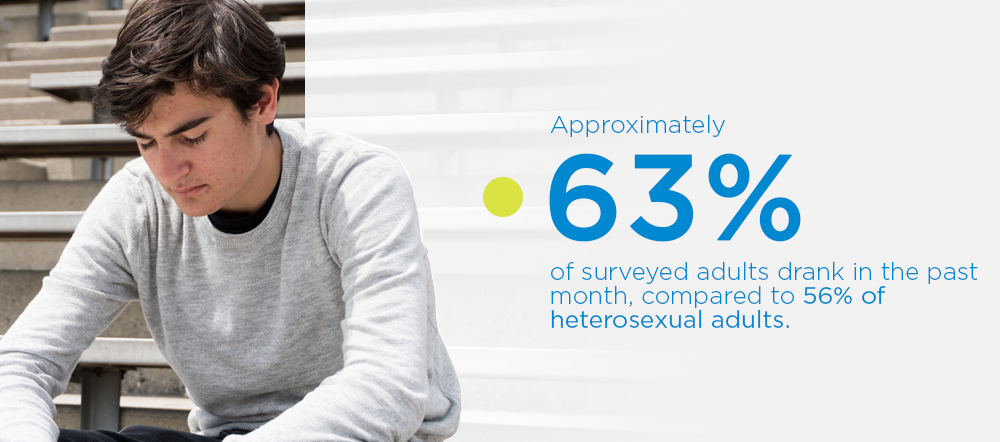
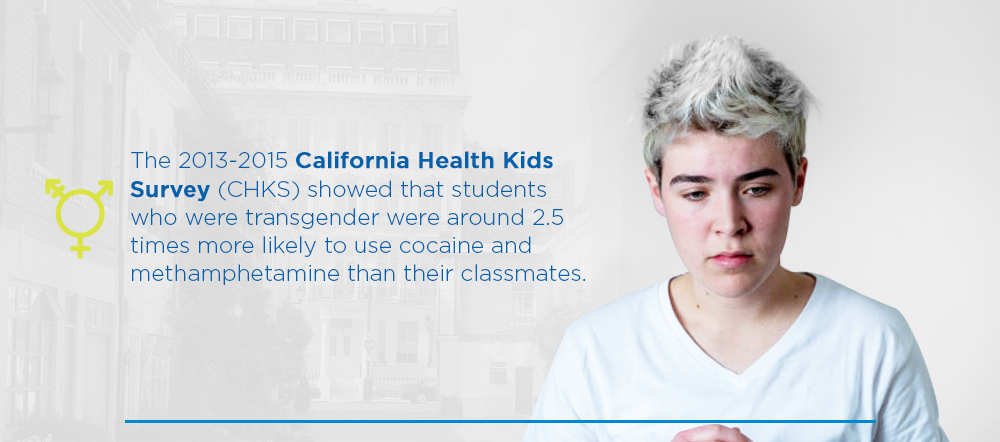
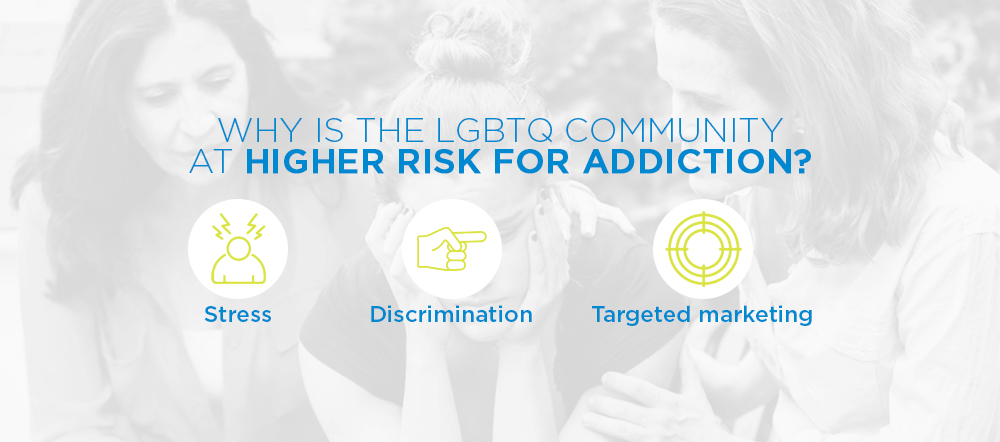
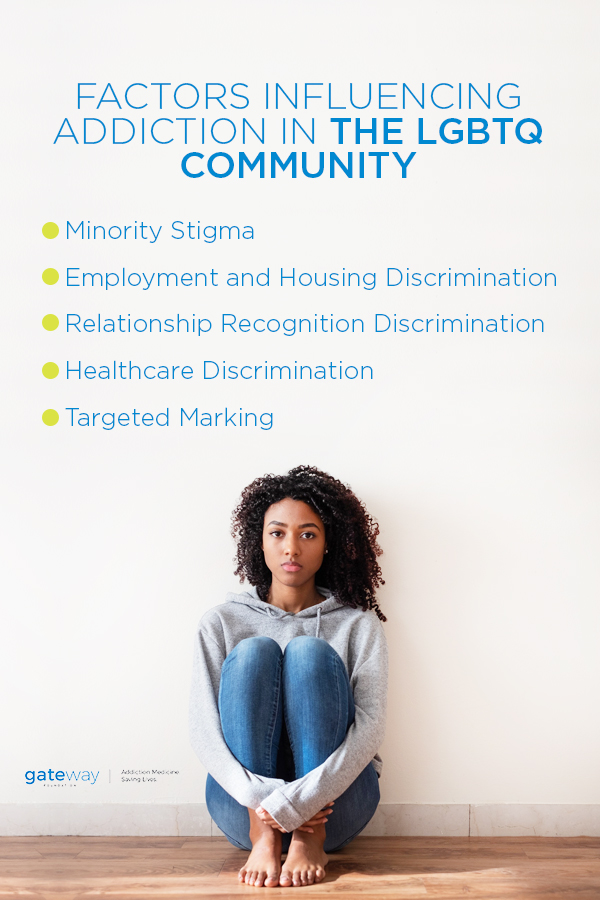
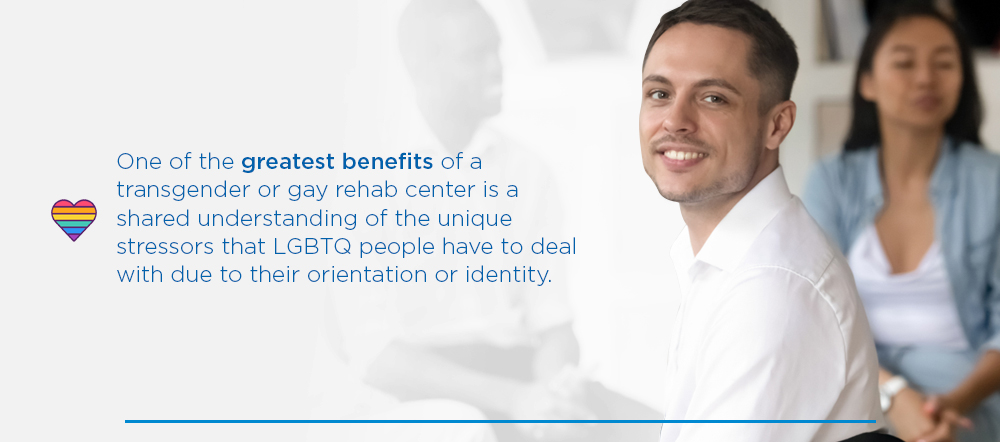 What Is an LGBTQ Rehab Center?
What Is an LGBTQ Rehab Center?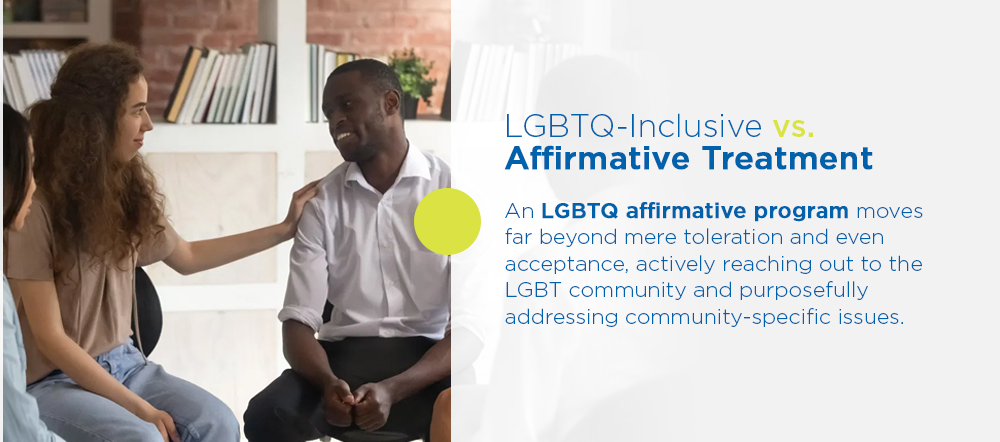 LGBTQ-Inclusive vs. Affirmative Treatment
LGBTQ-Inclusive vs. Affirmative Treatment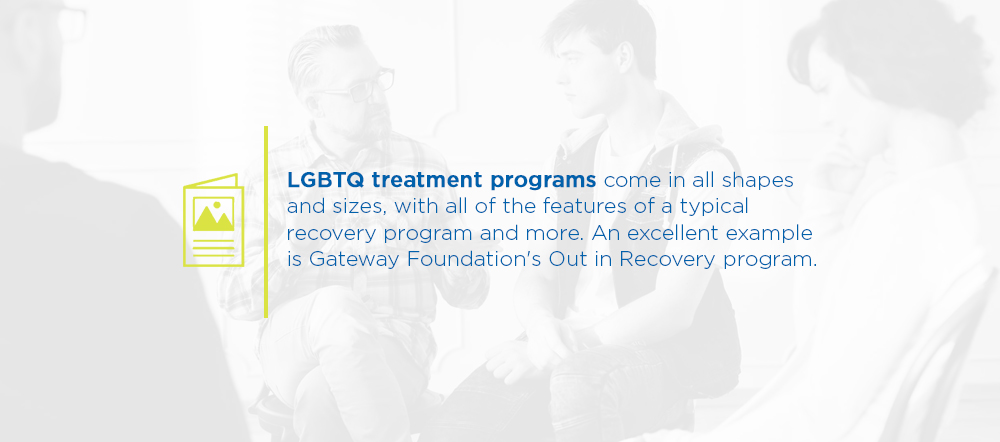
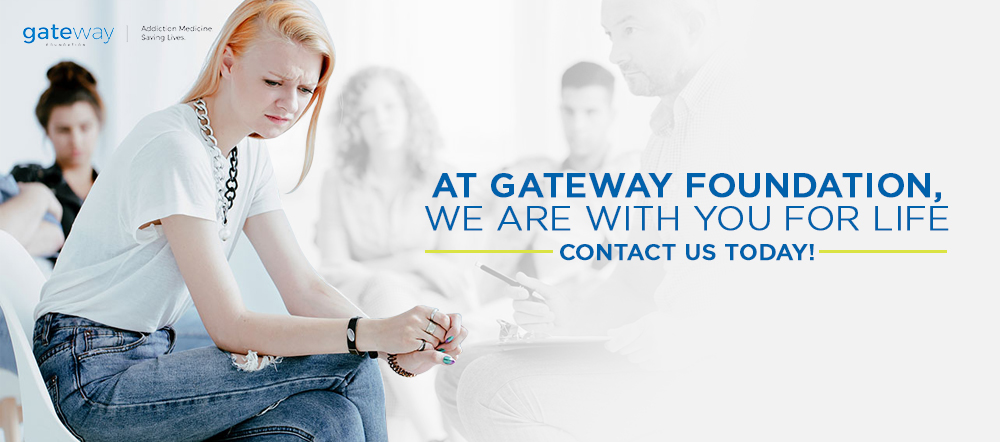 At Gateway Foundation, We Are With You for Life
At Gateway Foundation, We Are With You for Life
